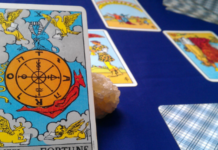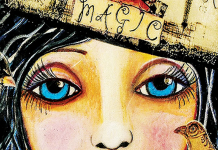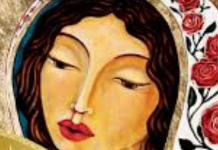
The Anubis Oracle: A Journey into the Shamanic Mysteries of Egypt
, by Nicki Scully and Linda Star Wolf, illustrated by Kris Waldherr
Bear & Company, 9781591430902, 165 pp., 2008
The Anubis Oracle contains a deck of thirty-five cards and a companion booklet bearing the same name as the kit.
Loosely inspired by Egyptian iconography, the illustrations in the deck are quite sweet with the same serene, soft imagery that helped make Kris Waldherr’s earlier Goddess Tarot Deck so popular.
The deck is comprised of thirty-five cards, the first twenty-two of which are numbered from zero to twenty-one in Arabic numerals, closely following the esoteric symbolism applied to the trump cards of the tarot, titled with the names of the neteru or Egyptian figures they’re to represent.
The cards following represent the four classical elements, and also use Arabic numerals, twenty-two to twenty-five: the Nile (Water), the Pyramid (Earth), the Desert (Fire) and the Crested Ibis (Air).
An additional eight cards numbered in the Roman fashion comprise the “Composite Cards”, the first seven of which combine three or more of the cards from the first twenty-two, while the last card, Alchemy, combines the five elements in a sort of Native American/Egyptian/New Age wheel.
Anubis himself figures in the Key Card, a card which can stand apart from the deck to “guide” the diviner, or use it in a reading “to make a direct connection with his wise counsel”.1
The book opens with a dubious claim to the oracle’s origins, the authors write that the “Tarot is a modern interpretation of the ancient oracle that connected the ancestors to the divine original source. Although here we sometimes use the language of tarot, the Anubis Oracle is an emerging new form that is more closely related to an ancient pre-tarot paradigm. This oracle is an elder of the modern-day tarot.”2
The tarot is well established as a Renaissance card game originating in Italy in about 1420. The ancient Egyptians, of course, did not have paper, and one can hardly imagine brittle papyrus a suitable medium for a game requiring repeated shuffling of this sort. The misguided theory that tarot originated in ancient Egypt was firmly discredited in the 1800s, but this fantasy persists among some of the more romantic esotericists.
In an interesting twist, a few pages after asserting that the Anubis oracle is “an elder of the modern-day tarot”, the authors explain their process for channelling the layout for the cards. Star Wolf acts as the seer, while on the opposite side of the country and over the phone, Scully acts akin to a “chemical catalyst”3 and scribe for the visions received.
Part I dedicates a two page chapter to each card in the deck with overwhelmingly positive interpretations for each card. Part II offers eight spreads following each of the Composite cards, and five sample readings to illustrate their use. Black and white images of the cards and/or spreads accompany each chapter dealing with the subject, which prove useful in acquainting oneself with the deck.
The Anubis Oracle is a visually attractive deck which will undoubtedly appeal to the New Age crowd, though those seeking a more historical approach to ancient Egypt may find the deck lacking.








